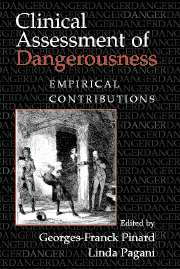Book contents
- Frontmatter
- Contents
- Contributors
- Prologue
- Introduction
- Basic Issues in Violence Research
- Mental Health Issues and Dangerousness
- Family Issues and Dangerousness
- 8 Risk Assessment for Intimate Partner Homicide
- 9 Parents at Risk of Filicide
- 10 Parricide
- Individual Characteristics and Dangerousness
- Conclusion
- Index
10 - Parricide
Published online by Cambridge University Press: 03 July 2009
- Frontmatter
- Contents
- Contributors
- Prologue
- Introduction
- Basic Issues in Violence Research
- Mental Health Issues and Dangerousness
- Family Issues and Dangerousness
- 8 Risk Assessment for Intimate Partner Homicide
- 9 Parents at Risk of Filicide
- 10 Parricide
- Individual Characteristics and Dangerousness
- Conclusion
- Index
Summary
As a boy, L. assaulted a hitchhiker and then urinated on him. As an adult, the 200-pound, alcohol and drug abuser routinely carried a pistol, stabbed and shot at his father, and terrorized his neighbors. For years, L. beat his wife. When she finally left him, he convinced a court to give him custody of their four children.
For the next four years, L. kept the children in an isolated trailer with no electricity, no phone, and no running water, allowing them out only to go to school. Inside the mobile home, L. beat the children with rubber hoses and two-by-fours, and punched, slapped, and kicked them. While drunk he would line the children up against the wall and ring their heads with gunfire.
L.'s reign of terror ended when his two older children, sons 15 and 12, shot him in the head with a deer rifle while he slept. Criminal charges against both boys were ultimately dismissed.
Sixteen-year-old J. had never been in trouble. An above-average student and member of the high school swim team, he was a Boy Scout and active member of his church. At the same time, however, J. was suffering from major depression, a learning disability, and chronic feelings of inferiority. After receiving disappointing scores on college admission tests and an “F” on a Spanish quiz, J. snapped.
Initially intent upon killing himself, J. instead turned his rage outward and used the family's. 22-caliber rifle to shoot and kill both his parents.
- Type
- Chapter
- Information
- Clinical Assessment of DangerousnessEmpirical Contributions, pp. 181 - 194Publisher: Cambridge University PressPrint publication year: 2000
- 9
- Cited by



